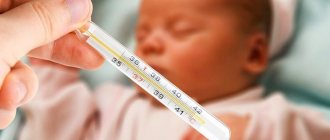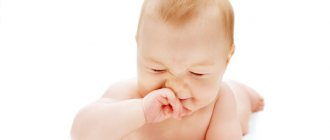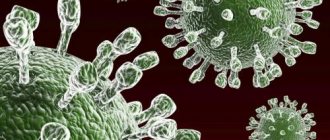Skin diseases in infants often appear in the first days after birth. Pemphigus in newborns, which must be treated, occurs a few days after the baby is born. The disease is characterized by numerous rashes on the baby’s skin. The rash consists of blisters with a pale yellow purulent liquid. Such manifestations can be either benign or malignant.
Causes and form of transmission
The main causative agent of the disease is Staphylococcus aureus. Let's study a small dossier on our common enemy.
Staphyloccocus aureus is the most harmful of all known bacteria of the staphylococcus family. It belongs to the opportunistic flora, as it becomes dangerous only under certain conditions. The rest of the time, Staphylococcus aureus lives quietly in colonies on human skin and mucous membranes. Up to 35% of medical personnel may be carriers of the bacterium.
The danger of staphylococcus is that it causes severe purulent inflammation, at the same time acquiring resistance to one antibiotic after another. For this reason, staph infections are generally difficult to treat.
Staphylococcus aureus poses a threat to both adults and newborns
According to other studies, pemphigus in children can be caused by streptococci or filterable viruses. So the causes of the disease are different.
Factors contributing to the spread of infection are almost always associated with weakened immunity (and in children it is just developing):
- prematurity;
- light weight;
- trauma during childbirth;
- open umbilical wound.
How to prevent the disease?
It is impossible to exclude a combination of circumstances that can cause pemphigus in a newborn. However, it is possible to narrow the range of ways the disease spreads if you treat women’s diseases in a timely manner before conception and childbirth, and also adhere to basic hygiene rules. The baby needs to be bathed regularly and his underwear changed.
Whether the child will be affected by this disease depends on the place where the woman is going to give birth. The expectant mother must be 100% sure that the maternity hospital she has chosen is clean and sterile.
The rooms for newborns are specially treated, and the medical staff has undergone a medical examination and always uses sterile gloves. And if someone is found to have purulent wounds, he should be removed from participation in childbirth and from caring for newborns.
Thus, the development of pemphigus largely depends on external factors. But do not forget that the ability to cope with infections is passed on from mother to child. Mom should not get sick during pregnancy and childbirth. She is obliged to eat quality food for two and lead a healthy lifestyle.
Epidemiology
We recommend reading: Why does a newborn’s skin peel?
Why is pemphigus of newborns called epidemic? Yes, because it is so contagious that it can cause an epidemic in maternity hospitals. Sources of infection are nurses, nurses, or mothers of newborns who have or have recently had pustular lesions on the skin (pyoderma). An infected umbilical cord becomes an entry point for infection. Even bacilli carriage can trigger the development of a disease that can grow to epidemic proportions.
Therefore, if a single manifestation of infection is detected, the sick child is isolated. If pemphigus in children becomes epidemic, the entire children's department is closed for disinfection. Not only the premises, but also the patients’ underwear are treated with disinfectant solutions.
Causes of pemphigus in newborns
Staphylococcus aureus The etiology of pemphigus in newborns is Staphylococcus aureus. This bacterium lives on the skin of healthy people, but is also the cause of a wide variety of purulent diseases: panaritium, furunculosis, abscesses of internal organs, phlegmon and many others. Infants become infected when the sanitary and epidemiological regime in the maternity hospital is violated, for example, through contact with medical staff suffering from pustular diseases of the skin of the hands.
The development of the disease is facilitated by the anatomical and physiological characteristics of the skin of a newborn. Its protective function is not as perfect as in adults; its immune components are not yet sufficiently developed. The skin of premature infants is most vulnerable, for whom a long hospital stay also plays a negative role, since the child is exposed to a large number of hospital strains of microorganisms that are resistant to the action of many antibiotics.
Forms
It is generally accepted that there are two forms of the disease.
Benign
It responds well to treatment, the body temperature is moderately elevated, the blisters with pus are flaccid, easily open and dry out, becoming covered with a crust. The outcome is favorable.
Malignant
It is characterized by a severe disease - Ritter's exfoliative dermatitis. Pathology goes through three stages:
- erythematous, when swelling and many blisters appear;
- exfoliative - subcutaneous fluid is formed, the bubbles burst and eroded areas of the skin are exposed, resembling a second-degree burn in appearance; intestinal disorders are expressed;
- regenerative - recovery stage, erosions heal, vomiting and diarrhea stop.
Ritter's exfoliative dermatitis is an extremely dangerous form of pemphigus.
It was noticed that the course of the disease in the first week of life is much more complicated than in the 2nd or 3rd week. Previously, this form of pemphigus was fatal in 50% of cases. Modern treatment allows in many cases to avoid unfavorable developments, but it is important to start it on time in order to avoid complications such as sepsis, pneumonia or meningitis.
Herpes
The virus is usually passed on to a child from an affected parent and can affect any part of the body. But most often, transparent pimples appear on the face of a newborn, usually in the lip area. The rash is accompanied by burning and itching.
Body temperature rises. After opening the blisters, ulcers remain on the skin. Sometimes the cervical lymph nodes become inflamed. If pathology occurs, antiviral agents are prescribed in the form of ointments, tablets, and injections. Antipyretic and immunostimulating drugs are also used.
Symptoms
The incubation period ranges from 3 to 7 days, that is, the main patients of this infectious disease are children 1-2 weeks old. It all starts with redness and the appearance of small pea-sized blisters. They are filled with a serous-yellow fluid (signs of pus), most often grouped in the umbilical region, in the folds of the arms, legs, neck and groin area, on the back, chest and buttocks. Sometimes bubbles are found on the mucous membrane in the mouth, which, of course, adds to the baby’s suffering.
At the same time, the child’s temperature rises from 38 to 39 °C, against which the appetite disappears, the baby is restless and sleeps poorly. Blood tests determine an increase in white blood cells, eosinophils and ESR.
Over time, the blisters burst, revealing eroded areas of bright red skin with remnants of the epidermis along the edges, which soon become crusty. Severe itching subsides and relief occurs.
Epidemic pemphigus of newborns takes quite a long time to treat. Thus, the uncomplicated form can last up to 5 weeks, where remissions are replaced by relapses.
Diagnostics
Diagnosis is made based on the infant's history and examination. Pay attention to:
- the age of the baby (pemphigus in children, as we found out, appears in the first weeks of their life);
- the nature of the rash (paroxysmal appearance of blisters, at the base of which there is no infiltrate, evolving at high speed).
This is what congenital syphilis looks like
The diagnosis is finally confirmed after bacteriological examination of the contents of the vesicles for the pathogen. The sensitivity of the microorganism to antibacterial drugs is immediately determined.
It is necessary to ensure that the diagnosis is correct, so differential diagnosis is carried out with congenital epidermolysis, syphilitic pemphigus and chickenpox. A few words about each disease:
Syphilitic pemphigus:
- signs are visible immediately after birth;
- there is an infiltrate at the base of the blisters;
- affected areas: soles, palms and buttocks;
- associated symptoms: syphilitic thickening of the skin in the mouth and chin, pale red skin, specific syphilitic rhinitis, treponema pallidum is found in the blisters, the Wasserman reaction is positive.
Congenital epidermolysis:
- occurs from the moment of birth;
- rashes are localized in areas of friction and increased trauma: knees, legs, elbows, hands, feet;
- the skin around the blisters is not inflamed, the blisters themselves are few;
- mucous membranes are almost never affected;
- in severe cases, dystrophic changes in nails, hair and teeth occur.
And so - congenital epidermolysis
Chicken pox:
- does not occur immediately after birth, since the incubation period ranges from 7 to 21 days;
- the bubbles are small, filled with a yellowish-transparent liquid, in most cases they dry out and open when rubbed;
- the rash spreads throughout the body, accompanied by severe itching.
Chickenpox is perhaps the most familiar disease, but no less dangerous in infancy
Treatment
Externally, the blisters are treated with disinfection solutions: brilliant green, salicylic or boric alcohol, diluted potassium permanganate. Treatment necessarily includes the prescription of penicillin, sulfonamide or cephalosporin antibiotics. In parallel, B vitamins, vitamin C, and immunomodulators can be prescribed.
If the prognosis is poor, treatment consists of massive antibiotic infusion therapy, sometimes with corticosteroids, antistaphylococcal gamma globulin and blood-based drugs.
First aid for blisters on the head in the hair
To reduce discomfort, you need not touch the blisters, do not peel off the crusts from them and do not squeeze out the contents of the inflamed follicles, even if there is itching and discomfort.
You need to switch to children's hypoallergenic shampoo, wash your hair with gentle, not sudden movements, so as not to damage the scalp.
In order to reduce discomfort, you need to wash your hair with menthol shampoo or make a mask from a strong decoction of mint with a few drops of tea tree oil and menthol, if the scalp does not dry out.
Preventive measures
Prevention comes down to timely detection of foci of pyoderma among medical personnel working in maternity hospitals and their removal from work for the duration of treatment. Mothers are told about the hygiene requirements for caring for their baby. In the wards, linen is regularly changed, wet cleaning and quartzing are done. All medical staff regularly undergo medical examinations, which include checking for staphylococcus bacilli.
So, pemphigus is rare in children, but at the same time it is an extremely serious disease. It takes a long time to heal, especially if a secondary infection occurs. Previously, when medicine did not have such a set of antibiotics in its arsenal, the disease was fatal in 50% of cases. However, now the mortality threshold has been significantly reduced. The main thing is to start treatment on time and take care of the baby’s strong immunity from birth.
Baby care
Children diagnosed with pemphigus require special treatment and more attentive daily care. How long the child can live depends on how the parents organize the baby’s life.
It is important to ensure that after discharge from the hospital, where the initial stage of treatment takes place, the baby continues to take all medications prescribed by the doctor at home.
Your child will need to treat eczema and skin blisters every day. For this, it is recommended to use aniline dyes (fucorcid, brilliant green), since they are quite effective against various microbes, and in particular against staphylococcus. It is recommended to apply corticosteroid ointment to erosions and crusts that have formed on the skin. Celestoderm is usually prescribed along with Garamycin or "". Dermatol ointment with an active ingredient concentration of 5% is also often used.
If signs of infection appear - pus, inflammation, swelling, it is imperative to use antibiotic ointments when treating them (“”, “”). If the affected areas are large, it is best to protect them from possible additional injury with a sterile bandage. Dressings should be done at least twice a day. Bandages also make sense for small lesions, if the child is very active and mobile.
If there are complaints of pain, it is sometimes allowed to give the child anti-inflammatory drugs “Ibuprofen” or “Paracetamol”; it is better to avoid taking “Analgin”. If pain relief cannot be achieved, you must consult a doctor who will give a prescription for analgesic drugs approved for use in childhood. If new elements of pemphigus and subsequent erosions appear in the mouth, you should ensure that the child rinses his mouth with antiseptic solutions several times a day.
The baby will benefit from baths to which parents add antiseptic solutions, such as chlorhexidine. It is advisable that the child take vitamin and mineral complexes that contain folic acid, vitamin E, calcium and magnesium. Changes will have to be made to the child’s diet. The baby should eat in small portions and fractionally (up to 6 times a day)
This is especially important if pemphigus has affected the mucous membranes in the mouth, in the esophagus. If the baby is not given pureed soups and mush porridges, which are relatively easy to eat, then he may refuse food altogether due to pain, and then he will have to be fed through a tube
The diet of a child with pemphigus should be based on avoiding salty foods; salt should be completely excluded from all recipes; however, the baby will need a large amount of protein foods.
Many vaccinations are contraindicated for a child who is taking drugs to suppress the immune system. But parents, if they wish, will be able to vaccinate their baby against influenza and pneumococcus.
A baby with pemphigus needs to sunbathe and swim with caution. This can only be done in a state of remission - when there are no fresh eczema and blisters on the skin
In most cases, children with severe forms of the disease are home-schooled; in some cases, they receive the status of a disabled child.
Pemphigus does not affect the mental and intellectual development of a child; the child can easily engage in any type of mental work. You should strictly limit the child’s contact with any allergens and toxic substances, household chemicals, and avoid traumatic situations in which the baby could get a burn or wound. Acute respiratory viral infections should also be avoided.










